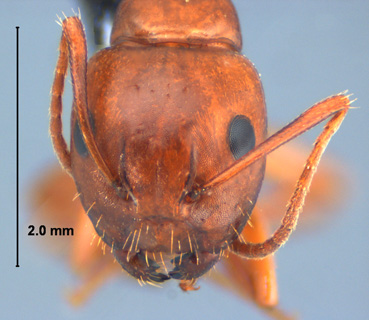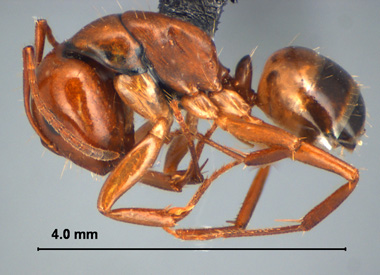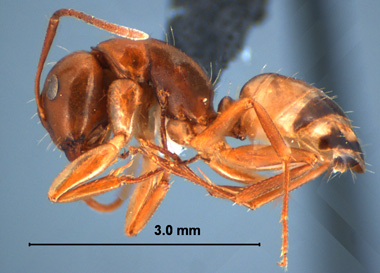Subfamily FORMICINAE |
|
 |
 |
Camponotus subbarbatus, view of the head of a major worker. Note the long erect setae along the margins of the clypeus and the numerous erect setae on the cheeks. |
Camponotus subbarbatus, profile view of a major worker. This is an atyically dark specimen with the banding of the gaster less conspicuous than is normally seen in this area making it closely resemble C. snellingi. However, the erect setae on the cheeks separate it from C. snellingi. |
 |
|
Camponotus subbarbatus, profile view of a major worker. |
|
Ants in the genus Camponotus are collectively known as carpenter ants because some species nest in wood, including man-made structure. This genus includes some of the largest and most common ants in the world, and they are found in all biogeographical regions (Bolton, 1995). More than 900 species of Camponotus are known worldwide, with 50 species reported from the United States (Hanson and Klotz, 2005), and 20 species found east of the Mississippi River (Deyrup, 2003; Smith, 1979). Species in this genus are variable in size with workers ranging in size from 3 to 15 mm or more in length and queens (also referred to as females) of some species attaining a length of 19 mm or more. Many species are polymorphic. Workers have a 12-segmented antenna that lacks an apical club. Antennal fossae do not touch the posterior border of the clypeus. Ocelli are not present on the heads of workers. The workers of most species have an indistinct metanotal suture between the promesonotum and the propodeum, although this suture is present in C. sexguttatus and some members of the subgenus Colobopsis. Those species that lack the obvoius and deep metanotal suture have the shape of the alitrunk in a smoothly curved arc (as seen in profile). This species is in the subgenus Myrmentoma, which can be generally characterized as having a notch or emargination in the middle of the anterior border of the clypeus.Camponotus subbarbatus Emery workers range from 3.5 to 6.5 mm in overall length. This species can be distinguished from others in the subgenus the erect hairs found on the gena (seen in majors, in minors there are few erect hairs present), long erect hairs located on and adjacent to the margins of the clypeus, and a few or no erect hairs on the clypeal disc. This species typically has a "banded" look to the gaster with dark stripes often present on a yellowish orange background. The coxae are usually strikingly pale in comparison to the alitrunk. Minor workers of C. subbarbatus may be hard to key to subgenus because the median notch in the clypeus, the main character for separation from the other subgenera, is not clearly evident. This species nests in rotting wood. Links |
|


